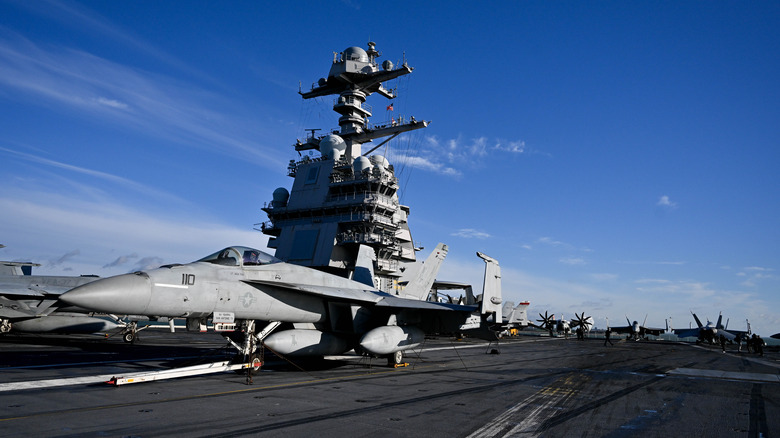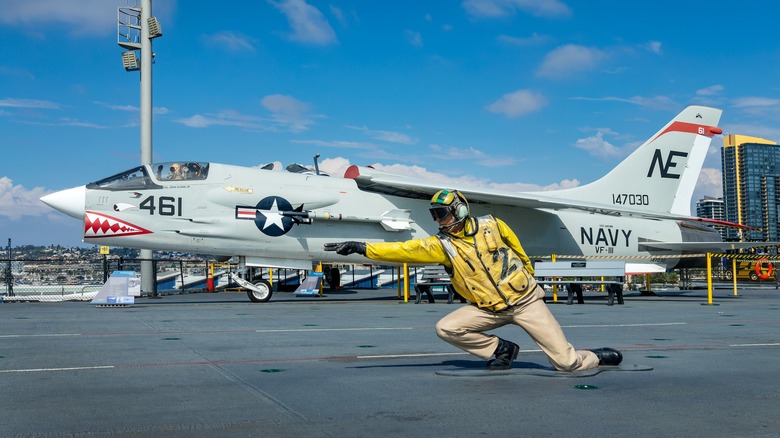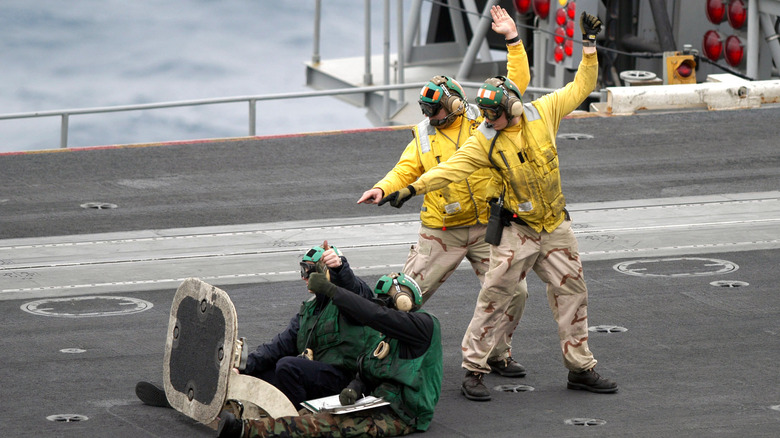
Finnbarr Webster/Getty Images
By Brad Hill/
How does one objectively measure what the most dangerous job in the navy is? Is it by how many people lose their lives in a year to that job? Do you measure how often the sailors are exposed to life-threatening situations? In this case, it’s measured by the number of potential hazards a person works near on a daily basis. Being in any branch of the military is dangerous on its own, but when it comes to the navy, working on one of the many aircraft carriers each country has is especially dangerous. With all 11 of America’s carriers being nuclear-powered, it’s easy to mistake working with the nuclear reactor being the most dangerous position aboard. While it’s a risky position if anything were to go wrong, it’s not the most dangerous. That label goes to the men and women working on the flight deck.
The ocean is an unforgiving place that doesn’t care about the people who travel across it. Throw in heavy machinery and speeding aircraft, and you get a recipe for potential disaster. Andrew Dean, a Safety Officer aboard the U.S.S. Nimitz, talked to ABC in 2022, discussing all the different hazards flight deck crew are exposed to. From loud noises and different pollutants in the air to the physical dangers of jet exhaust, flight deck crew put their lives on the line everyday they’re at sea.
Notable accidents on the flight deck

Delpixel/Shutterstock
Unfortunately, even events that are completely out of the flight deck crew’s control put them at risk. An EA-6B Prowler crashed on the USS Nimitz (CVN-68) in 1981, the oldest aircraft carrier still in service, killing 14 sailors and Marines while injuring 45 others.
During Operation Desert Storm, in 1991, a flight deck operator was sucked into an A-6 Intruder’s engine. Petty Officer JD Bridges was lucky enough to survive the incident. A fellow crewmate aboard the USS Theodore Roosevelt (CVN-71) recounted the event, saying that his helmet and coat being sucked in first partly saved him because it prompted the Intruder’s pilot to cut the throttle. The design of the Intruder’s engine was also responsible for the Petty Officer’s survival.
If it had been any other plane or any other engine, he might not have survived. A mechanic at El Paso International Airport tragically lost his life when he was sucked into the engine of a Boeing 737 in January 2006. Despite the ever-present hazards from working on the flight deck, it can be a fulfilling role. Melanie Cluck, a Petty Officer 3rd Class back in 2017, talked about the initial fear working on the flight deck, specifically wearing the yellow jersey that signifies the person in charge of directing aircraft, but once you get the hang of your job, a sense of pride overtakes that fear.
What it takes to work on the flight deck

U.s. Navy/Getty Images
When civilians think of naval jobs with high standards, they typically think about the U.S. Navy SEALs or naval aviators — jobs that get all the limelight and glory. They rarely think about how much effort goes into taking on the other jobs. Those working on the flight line have to wield impeccable situational awareness, being aware of multiple things happening around them simultaneously. It’s not a skill the everyday person has. Why would they? The average Joe isn’t in the middle of a high-stress scenario every time they clock in. As Senior Chief Naval Aircrewman (Helicopter) Aaron Hutchinson said in the Aviation Safety Blog, working on the flight deck demands «a vigilant ‘head on a swivel’ approach.»
There’s a slew of different positions on the flight deck that are all conveniently color-coded, so everybody knows what everyone else is responsible for. Those in a blue jersey are in charge of motorized tools like forklifts. Anyone in a purple jersey, commonly called «Grapes» and sometimes «Fuelies» are in charge of refueling aircraft. Those in green handle the maintenance, while the yellow shirts direct aircraft where to go. Then there’s the red shirts, who arm aircraft with bombs and missiles and brown jerseys who take charge of pre- and post-flight preparations. Those in white shirts are responsible for safety, medical, quality control, and a variety of other tasks. Every one of these men and women needs to work together to ensure their safety.